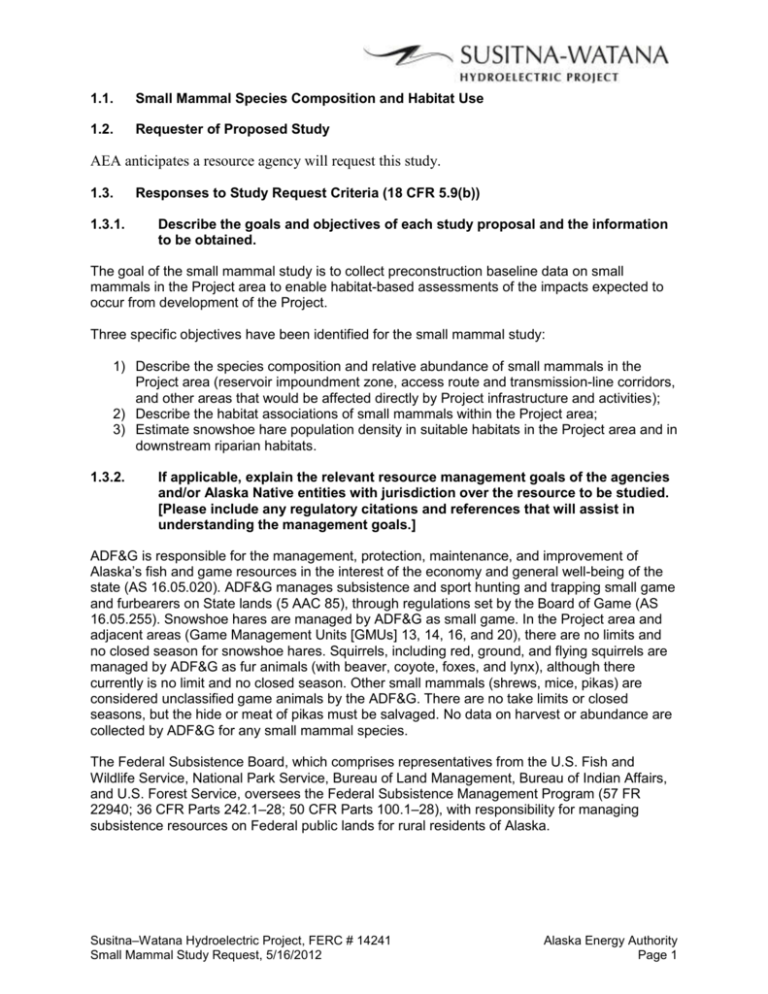Small Mammal Species Composition and Habitat Use (Redline)
advertisement

1.1. Small Mammal Species Composition and Habitat Use 1.2. Requester of Proposed Study AEA anticipates a resource agency will request this study. 1.3. 1.3.1. Responses to Study Request Criteria (18 CFR 5.9(b)) Describe the goals and objectives of each study proposal and the information to be obtained. The goal of the small mammal study is to collect preconstruction baseline data on small mammals in the Project area to enable habitat-based assessments of the impacts expected to occur from development of the Project. Three specific objectives have been identified for the small mammal study: 1) Describe the species composition and relative abundance of small mammals in the Project area (reservoir impoundment zone, access route and transmission-line corridors, and other areas that would be affected directly by Project infrastructure and activities); 2) Describe the habitat associations of small mammals within the Project area; 3) Estimate snowshoe hare population density in suitable habitats in the Project area and in downstream riparian habitats. 1.3.2. If applicable, explain the relevant resource management goals of the agencies and/or Alaska Native entities with jurisdiction over the resource to be studied. [Please include any regulatory citations and references that will assist in understanding the management goals.] ADF&G is responsible for the management, protection, maintenance, and improvement of Alaska’s fish and game resources in the interest of the economy and general well-being of the state (AS 16.05.020). ADF&G manages subsistence and sport hunting and trapping small game and furbearers on State lands (5 AAC 85), through regulations set by the Board of Game (AS 16.05.255). Snowshoe hares are managed by ADF&G as small game. In the Project area and adjacent areas (Game Management Units [GMUs] 13, 14, 16, and 20), there are no limits and no closed season for snowshoe hares. Squirrels, including red, ground, and flying squirrels are managed by ADF&G as fur animals (with beaver, coyote, foxes, and lynx), although there currently is no limit and no closed season. Other small mammals (shrews, mice, pikas) are considered unclassified game animals by the ADF&G. There are no take limits or closed seasons, but the hide or meat of pikas must be salvaged. No data on harvest or abundance are collected by ADF&G for any small mammal species. The Federal Subsistence Board, which comprises representatives from the U.S. Fish and Wildlife Service, National Park Service, Bureau of Land Management, Bureau of Indian Affairs, and U.S. Forest Service, oversees the Federal Subsistence Management Program (57 FR 22940; 36 CFR Parts 242.1–28; 50 CFR Parts 100.1–28), with responsibility for managing subsistence resources on Federal public lands for rural residents of Alaska. Susitna–Watana Hydroelectric Project, FERC # 14241 Small Mammal Study Request, 5/16/2012 Alaska Energy Authority Page 1 1.3.3. If the requester is not a resource agency, explain any relevant public interest considerations in regard to the proposed study. Wildlife resources are owned by the State of Alaska, and the Project could potentially affect these public interest resources. 1.3.4. Describe existing information concerning the subject of the study proposal, and the need for additional information. Small mammal species in the Susitna River basin include snowshoe hare, porcupine, hoary marmot, arctic ground squirrel, red squirrel, collared pika, and several species each of voles, mice, and shrews [little brown bats are the subject of a separate study request]. Species composition, relative abundance, and habitat use by small mammals were studied for the original Susitna Hydroelectric Project (SHP) in 1980 and 1981 along 49 trapline transects (using both snap-traps and pitfall traps) located in a variety of different habitat types in the middle and upper Susitna River basin (Kessel et al. 1982). The SHP study area for small mammals (Kessel et al. 1982) extended from Sherman (near Gold Creek) on the west to the mouth of the Maclaren River on the east and for approximately 16 km (10 miles) on each side of the Susitna River; no surveys of small mammals were conducted downstream from Sherman. Since completion of the original SHP studies, a new species of small mammal—the Alaska tiny shrew—was recognized and described (Dokuchaev 1997, MacDonald and Cook 2009). The earliest specimen known was trapped in 1982 near the upper Susitna River during the SHP study. By 2007, the total number collected statewide had increased to 38 specimens from at least 22 widely separated locations (Cook and MacDonald 2009), indicating the species was more widespread than originally thought. Early information indicated it occurred primarily in riparian habitats but, as trapping efforts expanded, it also was captured in scrub habitats. The Alaska Natural Heritage Program classified the Alaska tiny shrew as “unrankable” globally (GU), presumably because little information was available, and as “vulnerable” in the state (S3; AKNHP 2011), probably due to restricted range and relatively few populations. The species was included on BLM’s Alaska list of sensitive species (2010). No recent reports on small mammal studies in the middle or upper Susitna basin are available. Other studies in surrounding regions included species inventories in Denali National Park and Preserve (Cook and MacDonald 2003) and on Fort Richardson near Anchorage (Peirce 2003), and long-term population monitoring (1992–2005) of three species of voles was conducted in Denali National Park and Preserve by Rexstad and Debevec (2006). The SHP studies provided a thorough sampling of the small mammal populations in the project area. Although 30 years have elapsed since those studies, it is unlikely that species distribution patterns or habitat use have changed significantly in the interim. Because of the often cyclical population fluctuations of small mammals and the lack of effective mitigation to offset population losses in the impoundment zone, the wildlife data-gap analysis report (ABR 2011) questioned whether additional studies are warranted for the Project. A current field survey focused on the reservoir impoundment zone, access and transmission corridors, and associated areas of infrastructure would provide useful information for evaluating the direct effects of habitat loss on small mammals. Because of the ecological importance of the species as an herbivore and prey animal for carnivores and raptors, current estimates of snowshoe hare population density should be obtained in the same area, as well as in downstream riparian habitats. Susitna–Watana Hydroelectric Project, FERC # 14241 Small Mammal Study Request, 5/16/2012 Alaska Energy Authority Page 2 1.3.5. Explain any nexus between project operations and effects (direct, indirect, and/or cumulative) on the resource to be studied, and how the study results would inform the development of license requirements. For small mammals, the Project will result in habitat loss and alteration, habitat fragmentation, disturbance, and direct and indirect mortality due to development activities. The small mammal study would provide baseline data for the Project area, including habitat use data for development of habitat evaluation criteria. The study would provide data to assess the following direct, indirect, and cumulative effects: Direct and indirect loss and alteration of wildlife habitats from Project construction and operation; Potential physical and/or behavioral blockage and alteration of movements due to reservoir water and ice conditions, access and transmission corridors, and new patterns of human activities and related indirect effects, including habitat connectivity and genetic isolation; Potential direct mortality due to Project-related fluctuations in water and ice conditions in the reservoir and downstream river reaches; Potential direct, indirect, and cumulative impacts on predator and prey abundance and distribution related to increased human activities and habitat changes resulting from Project development; Potential direct behavioral impacts to wildlife, such as attraction or avoidance, resulting from vehicular use, noise, and increased human presence associated with Project construction or operation; Potential indirect behavioral impacts to wildlife, such as attraction or avoidance, resulting from changes in hunting, vehicular use, noise, and increased human presence associated with increased subsistence or recreational access that may be facilitated by Project development; Potential direct mortality due to vehicle strikes, exposure to contaminants, attraction to garbage and human activity, and protection of life and property; and Potential changes in wildlife mortality rates due to increased subsistence and sport harvest facilitated by Project development. The small mammal study would provide a basis for impact assessment; developing any necessary protection, mitigation, and enhancement (PME) measures; and developing resource management and monitoring plans. 1.3.6. Explain how any proposed study methodology (including any preferred data collection and analysis techniques, or objectively quantified information, and a schedule including appropriate field season(s) and the duration) is consistent with generally accepted practice in the scientific community or, as appropriate, considers relevant tribal values and knowledge. In combination with the wildlife habitat mapping effort, the small mammal survey would provide data with which to evaluate the potential impacts of the Project. As in the landbird and shorebird study, sampling locations would be distributed across the landscape and allocated by habitat type to ensure that all the prominent habitats are sampled. Sampling locations would be allocated using a pseudo-stratified random plot allocation procedure, using aerial-photo signatures as the sampling strata because a current and complete habitat map likely will not be available by the time sampling would begin in 2013. Alternatively, the field survey could be Susitna–Watana Hydroelectric Project, FERC # 14241 Small Mammal Study Request, 5/16/2012 Alaska Energy Authority Page 3 postponed until 2014 to take advantage of the vegetation and habitat mapping that will have advanced by that time. Standard trapping methods for small mammals would be used (e.g., Jones et al. 1996), including both pitfall traps and snap-traps for voles, lemmings, and shrews, and pellet group counts for snowshoe hares (in combination with the hare sampling proposed for the separate terrestrial furbearer study). Pitfall traps will be plastic, as opposed to metal, to improve trapping success for the Alaska tiny shrew. Trapping data will include the relative abundance of each species in each habitat, allowing a quantitative assessment of habitat loss and habitat connectivity. Snowshoe hare pellet group counts also would be conducted in downstream riparian habitats and would extend over 2 years to better characterize the current phase of the dramatic population cycle exhibited by the species. 1.3.7. Describe considerations of level of effort and cost, as applicable, and why any proposed alternative studies would not be sufficient to meet the stated information needs. Detailed estimates of effort have not yet been developed, but a single season of trapping effort, consisting of 1 to 2 weeks of field trapping by two crews (two biologists each) in late summer 2013 or 2014 (when small mammal populations should have reached their highest seasonal levels), would be adequate to satisfy the study objectives for most small mammals. The exception would be the field survey of snowshoe hare density in the downstream riparian study area, which would be conducted in both years. The study area would consist of the same area covered by the vegetation mapping effort to provide a landscape context in which to evaluate the study results. Snowshoe hare density estimation would extend downstream to the Chulitna River confluence, and possibly could be combined with riparian habitat mapping. At this writing, no alternative studies have been proposed specifically for small mammals, although the terrestrial furbearer study request includes sampling to evaluate prey population density (snowshoe hares and voles). 1.3.8. Literature Cited ABR. 2011. Wildlife data-gap analysis for the proposed Susitna-Watana Hydroelectric Project. Draft report, August 16, 2011, prepared for the Alaska Energy Authority by ABR, Inc.— Environmental Research & Services, Fairbanks, Alaska. 114 pp. AKNHP (Alaska Natural Heritage Program). 2011. Species tracking list (updated January 2011). Alaska Natural Heritage Program, University of Alaska, Anchorage. 31 pp. Available online: http://aknhp.uaa.alaska.edu/wp-content/uploads/2010/11/ All_Tracking_Lists_Combined1.pdf (accessed 12 August 2011) BLM (Bureau of Land Management). 2010. BLM–Alaska sensitive animal and plant lists. Alaska State Office, Anchorage. Cook, J. A., and S. O. MacDonald. 2003. Mammal inventory of Alaska’s national parks and preserves: Denali National Park and Preserve. 2002 annual report for National Park Service, Alaska Region Survey and Inventory Program, Anchorage, by Idaho State University, Pocatello. 24 pp. Dokuchaev, N.E. 1997. A new species of shrew (Soricidae, Insectivora) from Alaska. Journal of Mammalogy 78: 811–817. Susitna–Watana Hydroelectric Project, FERC # 14241 Small Mammal Study Request, 5/16/2012 Alaska Energy Authority Page 4 Jones, C., W. J. McShea, M. J. Conroy, and T. H. Kunz. 1996. Capturing mammals. Pages 115–155 in D. E. Wilson, F. R. Cole, J. D. Nichols, R. Rudran, and M. S. Foster, editors. Measuring and Monitoring Biological Diversity: Standard Methods for Mammals. Smithsonian institution Press, Washington, DC. Kessel, B., S. O. MacDonald, D. D. Gibson, B. A. Cooper, and B. A. Anderson. 1982. Susitna Hydroelectric Project environmental studies, Phase I final report—Subtask 7.11: Birds and non-game mammals. Report by University of Alaska Museum, Fairbanks, and Terrestrial Environmental Specialists, Inc., Phoenix, NY for Alaska Power Authority, Anchorage. 149 pp. MacDonald, S. O., and J. A. Cook. 2009. Recent Mammals of Alaska. University of Alaska Press, Fairbanks. 387 pp. Peirce, K. N. 2003. A small mammal inventory on Fort Richardson, Alaska. Report by Center for Environmental Management of Military Lands, Colorado State University, for U.S. Army Environmental Resources Department, Fort Richardson, Alaska. 40 pp. Rexstad, E., and E. Debevec. 2006. Dynamics of small mammal populations in the Rock Creek watershed, Denali National Park and Preserve. Alaska Park Science 6: 69–72. Available online: http://www.nps.gov/akso/AKParkScience/symposium2006/rexstad.pdf (accessed 10 August 2011) Susitna–Watana Hydroelectric Project, FERC # 14241 Small Mammal Study Request, 5/16/2012 Alaska Energy Authority Page 5









